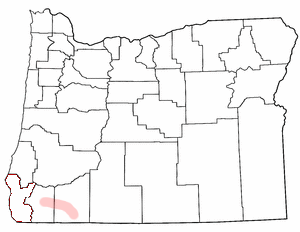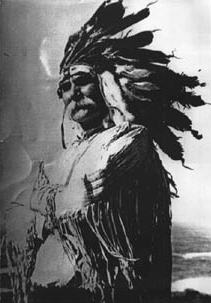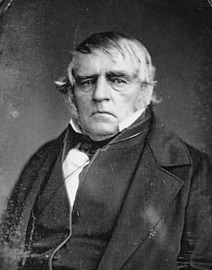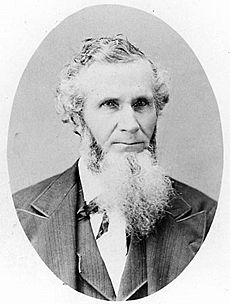Rogue River Wars facts for kids
Quick facts for kids Rogue River War |
|||||||
|---|---|---|---|---|---|---|---|
| Part of American Indian Wars | |||||||
|
|||||||
| Belligerents | |||||||
U.S. Army local militias and volunteers |
Rogue River Indians | ||||||
| Commanders and leaders | |||||||
| Andrew Jackson Smith Robert C. Buchanan |
Tecumtum | ||||||
| Casualties and losses | |||||||
| 33 volunteers killed 17 regulars killed 44 civilians killed |
around 100+ killed | ||||||
The Rogue River Wars were a series of fights that happened between 1855 and 1856. These conflicts were in southern Oregon. They involved the U.S. Army, local groups of armed citizens, and Native American tribes. These tribes are often called the Rogue River Indians.
Even though the main war was in 1855–1856, smaller fights had been happening since the 1830s. These earlier clashes were between European-American settlers and Native Americans. They were mostly about land and natural resources.
After the war ended, the United States moved many Native American tribes. This included the Tolowa people and other tribes. They were sent to special areas called reservations in Oregon and California.
One of these places was the Coast Indian Reservation in central Oregon. It is now called the Siletz Reservation. Many different tribes were moved there. While these tribes once spoke many languages, today the main native language is Siletz Deen-ni.
Contents
Why the War Started
Early Encounters
At first, when European-American settlers first came to the Rogue River area, things were fairly calm. But this changed a lot when the Oregon Trail opened. Also, gold was discovered in northern California. This brought many more settlers and miners to the area.
These new arrivals used up the natural resources that the Native Americans needed to live. They hunted and fished, taking food away from the tribes. They also cut down many oak trees.
The first recorded fights happened in 1834. A group led by an American named Ewing Young killed several Native Americans. The local tribe found the bodies and fought back the next year. They attacked an American fur trapping group. Four of the eight European-Americans were killed.
In 1837, another event caused more trouble. A man named George K. Gay shot and killed a native boy. He said it was revenge for earlier attacks. In response, local Native Americans raided a cattle drive.
Different Ways of Life
The first time Europeans met these Native American groups was in 1826. A British explorer named George Vancouver anchored his ship near Cape Blanco. Native people visited his ship in canoes.
In 1827, a group from the Hudson's Bay Company (HBC) met the inland Rogue River people. This group was led by Peter Skene Ogden. They were looking for beavers for the fur trade. At first, there were not many problems between the groups.
However, in 1834, an HBC group was said to have killed 11 Rogue River natives. Soon after, another American group killed at least two more. The name Rogue River came from French fur trappers. They called the river La Riviere aux Coquins, meaning "River of Rogues." They thought the native people were "rogues."
More European settlers came to the Rogue River area after 1846. A new trail, the Applegate Trail, was created. It went through the Rogue and Bear Creek valleys. Many wagons and emigrants used this new trail. They passed through the homelands of the Rogue tribes. Even with fears on both sides, there was not much violence in the 1830s and 1840s.
In 1847, the Whitman massacre happened in what is now Washington. This made European settlers in Oregon very worried. They formed large groups of armed citizens called militias. Tensions grew even more in 1848 with the start of the California Gold Rush. Many miners from Oregon went through the Rogue Valley.
After Native Americans attacked a group of miners in 1850, a peace treaty was made. Former governor Joseph Lane made the treaty with Apserkahar, a leader of the Takelma tribe. It promised to protect Native American rights. It also allowed miners and settlers to pass safely through the Rogue Valley.
Gold Mining in the Valley
Miners started looking for gold in the area. They set up a mining camp in 1851. This camp later became the town of Jacksonville. Native American attacks on miners that year led to the U.S. Army getting involved. There was fighting near Table Rock.
The new governor, John P. Gaines, made a new treaty. It moved some Native American groups from Bear Creek. Around the same time, more white settlers, including families, moved into the region. By 1852, many land claims had been made in the Rogue Valley.
More fights in 1853 led to the Table Rock Treaty. This treaty created the Table Rock Indian Reservation. It was across the river from a federal army post called Fort Lane. As more white people arrived, Native Americans lost more land and food sources. This led to more violence from 1854 to 1855.
The Rogue River War
In 1855, these problems led to a full-scale war. This war lasted into 1856. It is now known as the Rogue River War.
Here is a summary of what happened:
- In the 1850s, Governor Stevens of Washington Territory wanted to take land from Native Americans. The U.S. Army did not agree with this.
- White settlers in the Rogue River area began attacking Native American villages.
- Captain Smith, who was in charge of Fort Lane, often protected the Native Americans.
- In October 1855, Captain Smith brought Native American women and children into the fort for safety.
- However, a group of settlers attacked their village outside the fort. They killed 27 Native Americans.
- The Native Americans fought back, killing 27 settlers.
- Settlers continued to attack Native American camps through the winter.
- On May 27, 1856, Captain Smith tried to arrange for the Native Americans to surrender. But the Native Americans attacked the soldiers instead.
- The soldiers fought until more help arrived the next day. The Native Americans then retreated.
- A month later, the Native Americans surrendered. They were sent to reservations.
Many Native Americans on the Table Rock Reservation were suffering from cold, hunger, and sickness. In October 1855, a group of Takelma people went back to their old village. A volunteer militia attacked them, killing 23 people. They then fled downriver, attacking white settlers.
The war ended at a place called Big Bend on the lower river. By then, fighting had also ended near the coast. There, another group of Native Americans had killed about 30 white people and burned their homes.
Most of the Rogue River Indians were moved in 1856 to reservations further north. About 1,400 were sent to the Siletz Reservation in central Oregon. They were placed with other tribes. To protect 400 Native Americans still at Table Rock, Joel Palmer, the Oregon Superintendent of Indian Affairs, ordered them moved. They went to the new Grande Ronde Reservation.
The Battle of Hungry Hill
The Battle of Hungry Hill was the biggest fight of the Rogue River Wars. It happened on October 31, 1855. Native Americans, including women and children, were camped on top of a hill. The soldiers were across a deep ravine.
About 200 Native Americans were in the mountains. They had guns, bows, and arrows. They were able to hold off more than 300 soldiers and armed citizens.
|





